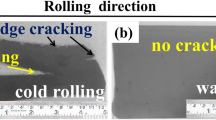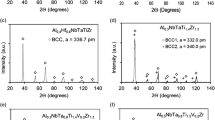We study the influence of hydrogen under a pressure of up to 30 MPa with contents of up to 20 wppm on the strength, plasticity, low-cycle fatigue, and short- and long-term crack-growth resistances of five modifications of Ni56Cr17Mo6Nb4 alloy (KhN56MBYuD) (EK-62), which differ by the methods of metallurgical remelting, chemical compositions, and modes of heat treatment. It is shown that the fracture toughness in air and in hydrogen decrease as the grain size decreases and the yield strength and HRC hardness increase, which enables us to predict the changes in the crack resistance according to the data of hardness measurements of the surfaces of workpieces operating in hydrogen. The optimal combination of high strength, plasticity, and short- and long-term crack-growth resistances in air and in hydrogen is attained for the modification alloyed with boron (0.005 wt.%) and zirconium (0.044 wt.%). In the tests for long-term crack-growth-resistance carried out for 100 h, we established the invariant characteristics of crack-growth resistance, namely the threshold values of K IHST varying from 15 to 35 MPa∙m1/2 for different modifications of the alloy.







Similar content being viewed by others
References
E. Bancalari, P. Chan, and I. S. Diakunchak, “Advanced hydrogen turbine development,” in: Proc. of the 24th Annual Internat. Pittsburgh Coal Conf., University of Pittsburgh (2007), pp. 1–16.
R. G. Hugh, Embrittlement of Nickel-, Cobalt-, and Iron-Base Superalloys by Exposure to Hydrogen, NASA Technical Note, TN D-7805, National Aeronautics and Space Administration, Washington (1975), pp. 1–44.
F. F. Khimushin, Refractory Steels and Alloys [in Russian], Metallurgiya, Moscow (1978).
C. T. Sims and W. C. Hagel (editors), The Superalloys, Wiley, New York (1970).
R. A. Melekhov and V. I. Pokhmurs’kyi, Structural Materials of Power-Generating Equipment. Properties and Degradation [in Ukrainian], Naukova Dumka, Kyiv (2003).
A. I. Balitskii and V. V. Panasyuk, “Workability assessment of structural steels of power plant units in hydrogen environments,” Probl. Prochn., No. 1, 69–75 (2009); English translation: Strength Mater., 41, No. 1, 69–75 (2009).
V. V. Panasyuk and I. M. Dmytrakh, “Strength of structural metals in hydrogen-containing media,” in: Physicomechanical Institute (to the 60th Anniversary of Its Foundation) [in Ukrainian], Spolom, Lviv (2011), pp. 101–120.
N. A. Sorokina, T. K. Sergeeva, Yu. A. Rusinovich, Rastorgueva I. A., V. I. Goltsova, and L. A. Shumilov, “Hydrogenembrittlement resistance of nickel alloys with different alloy contents,” Fiz.-Khim. Mekh. Mater., 21, No. 1, 27–31 (1985); English translation: Mater. Sci., 21, No. 1, 25–30 (1985).
Y. Amouyal and D. Seidman, “The role of hafnium in the formation of misoriented defects in Ni-based superalloys: An atom-probe tomographic study,” Acta Mater., 59, 3321–3333 (2011).
GOST 25506–85. Methods for Mechanical Testing of Metals. Determination of the Characteristics of Crack Resistance (Fracture Toughness) under Static Loading [in Russian], Izd. Standartov, Moscow (1985).
W. F. Brown, Jr. and J. E. Srawley, Plane Strain Crack Toughness Testing of High Strength Metallic Materials. ASTM Special Technical Publication No. 410, American Society for Testing and Materials, National Aeronautics and Space Administration, Philadelphia (1966).
ASTM E 813–89, “Standard test method for JIC, a measure of fracture toughness,” in: Annual Book of ASTM Standards, Vol. 03.01, ASTM, Philadelphia (1994), pp. 732–746.
M. O. Speidel and M. V. Hyatt, “Stress-corrosion cracking of high-strength aluminum alloys,” in: M. G. Fontana and R. G. Staehle (editors), Advances in Corrosion Science and Technology, Vol. 2, Plenum Press, New York (1972), pp. 115–335.
LECO TCH 600 Series (Nitrogen, Oxygen, Hydrogen Determination), LECO Corporation, (2003).
L. M. Ivas’kevych, A. I. Balyts’kyi, and V. M. Mochul’s’kyi, Influence of hydrogen on the static crack resistance of refractory steels,” Fiz.-Khim. Mekh. Mater., 48, No. 3, 78–86 (2012); English translation: Mater. Sci., 48, No. 3, 345–354 (2012).
O. N. Romaniv, Fracture Toughness of Structural Steels [in Russian], Metallurgiya, Moscow (1979).
V. V. Panasyuk, Mechanics of Quasibrittle Fracture of Materials [in Russian], Naukova Dumka, Kiev (1991).
B. A. Kolachev, A. V. Malkov, and V. I. Sedov, “Use of linear mechanics of fracture in studying hydrogen embrittlement of titanium alloys,” Fiz.-Khim. Mekh. Mater., 11, No. 6, 7–12 (1975); English translation: Mater. Sci., 11, No. 6, 624–628 (1975).
S. Ni, Y. B. Wang, X. Z. Liao, S. N. Alhajeri, H. Q. Li, Y. H. Zhao, E. J. Lavernia, S. P. Ronger, T. G. Langdon, and Y. T. Zhu, “Grain growth and dislocation density evolution in a nanocrystalline Ni–Fe alloy induced by high-pressure torsion,” Scripta Mater., 64, 327–330 (2011).
Treatise on Materials Science and Technology, Vol. 25: C. L. Briant and S. K. Banerji (editors), Embrittlement of Engineering Alloys, Academic Press, New York (1983).
S. B. Maslenkov and E. A. Maslenkova, Steels and Alloys for High Temperatures: A Handbook [in Russian], Vol. 2, Metallurgiya, Moscow (1991).
B. A. Kolachev, Hydrogen Brittleness of Metals [in Russian], Metallurgiya, Moscow (1985).
V. I. Tkachev, V. I. Kholodnyi, and I. N. Levina, Serviceability of Steels and Alloys in Hydrogen [in Russian], Vertikal’, Lvov (1999).
A. I. Balitskii, L. M. Ivaskevich, and V. M. Mochulskyi, “Temperature dependences of age-hardening austenitic steels mechanical properties in gaseous hydrogen,” in: M. Elboujdaini (editor), Proc. on CD ROM of the 12th Internat. Conf. on Fracture, NRC, Ottawa (2009), paper No. T19.001.
A. W. Thompson and I. M. Bernstein, “The role of metallurgical variables in hydrogen-assisted environmental fracture” in: M. G. Fontana and R.G. Staehle (editors), Advances in Corrosion Science and Technology, Vol. 7, Plenum Press, New York (1980), pp. 53–175.
O. I. Balyts’kyi, L. M. Ivas’kevych, V. M. Mochul’s’kyi, and O. M. Holiyan, “Influence of hydrogen on the crack resistance of 10Kh15N27T3V2MR steel,” Fiz.-Khim. Mekh. Mater., 45, No. 2, 102–110 (2009); English translation: Mater. Sci., 45, No. 2, 258–267 (2009).
H. G. Nelson, “Hydrogen embrittlement,” in: Treatise on Materials Science and Technology, Vol. 25: C. L. Briant and S. K. Banerji (editors), Embrittlement of Engineering Alloys, Academic Press, New York (1983), pp. 275–359.
T. S. Doyle, Z. Dehouche, and S. Stankovic, “Decentralized power and heat derived from an eco-innovative integrated gasification fuel cell combined cycle fuelled by waste,” Int. J. Hydrogen Energy, 40, 9013–9025 (2015).
D. Locq and P. Caron, “On some advanced nickel-based superalloys for disk applications,” Aerospace Lab J., Issue 3, 1–9 (2011).
B. S. Loberg, S. V. Ovsepyan, and E. V. Baburina, “Numerical analysis of the heat resistance of complexly alloyed nickel alloys with the help of equations of the system of nonpolarized ion radii (SNIR),” Metalloved. Term. Obrab. Met., No. 6, 9–11 (1995).
B. P. Somerday, M. Dadfarnia, K. A. Nibur, C. H. Cadden, and P. Sofronis, “Hydrogen-assisted crack propagation in austenitic stainless steel fusion welds,” Metall. Mater. Trans. A, 40a, 2350–2362 (2009).
T. Michler and J. Naumann, “Hydrogen embrittlement of Cr–Mn–N-austenitic stainless steels,” Int. J. Hydrogen Energy, 35, 1485–1492 (2010).
T. Michler, J. Naumann, and M. P. Balogh, “Hydrogen environment embrittlement of solution treated Fe–Cr–Ni superalloys,” Mater. Sci. Eng. A, 607, 71–80 (2014).
Z. Guo, M. Zhao, C. Li, S. Chen, and L. Rong, “Mechanism of hydrogen embrittlement in a gamma-prime phase strengthened Fe–Ni based austenitic alloy,” Mater. Sci. Eng. A, 555, 77–84 (2012).
Author information
Authors and Affiliations
Corresponding author
Additional information
Translated from Fizyko-Khimichna Mekhanika Materialiv, Vol. 51, No. 4, pp. 91–99, July–August, 2015.
Rights and permissions
About this article
Cite this article
Balyts’kyi, О.І., Mochul’s’kyi, V.М. & Ivas’kevych, L.М. Evaluation of the Influence of Hydrogen on the Mechanical Characteristics of Complexly Alloyed Nickel Alloys. Mater Sci 51, 538–547 (2016). https://doi.org/10.1007/s11003-016-9873-9
Received:
Published:
Issue Date:
DOI: https://doi.org/10.1007/s11003-016-9873-9




